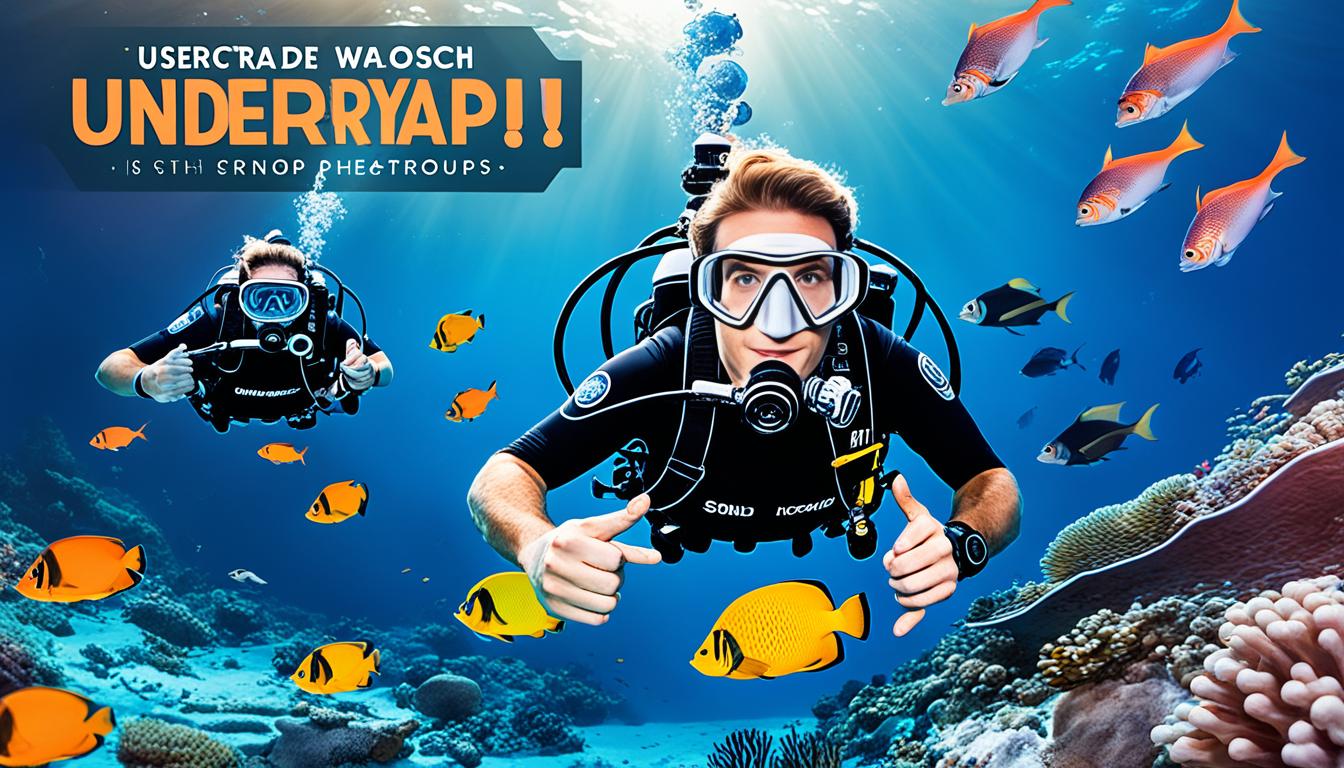Underwater photography is a fascinating genre that requires specific equipment and knowledge of photography basics. To capture stunning underwater images, you need to understand the effects of water on your photos and make use of specialized gear. This section will provide an introduction to underwater photography and cover the essential equipment and techniques needed to get started.
Key Takeaways:
- Underwater photography requires specialized equipment and knowledge of photography basics.
- Understanding the effects of water is crucial for capturing stunning underwater images.
- Investing in underwater camera gear and housing is essential for protecting your camera and operating it underwater.
- Mastering underwater lighting techniques and composition can greatly enhance your underwater photos.
- Exploring different underwater photography settings and techniques will help you achieve the desired results.
Underwater Photography Basics
Underwater photography is an exciting realm that comes with its own set of terminology and necessary equipment. To navigate this captivating world effectively, it is crucial to familiarize yourself with these fundamental concepts and tools. Let’s dive in:
Underwater Housing
An underwater housing is a protective case specially designed to enclose your camera, allowing you to operate it underwater. It ensures the safety of your equipment against water damage and offers easy access to essential camera controls, enabling you to capture stunning images beneath the surface.
Strobe or Flash
A strobe or flash is an external light source that adds color and brightness to your underwater photos. It compensates for the loss of red and orange hues at greater depths, resulting in vibrant and well-exposed images. A strobe or flash is a must-have accessory for achieving professional-looking underwater shots.
Macro Lens
A macro lens is a type of lens that allows you to capture intricate details of small underwater subjects. It provides a close focusing distance, enabling you to photograph tiny marine creatures with exceptional clarity and sharpness. Shooting macro allows you to explore the fascinating world of underwater microcosms.
Wide-Angle Lens
A wide-angle lens is ideal for capturing expansive underwater scenes and large subjects such as coral reefs and shipwrecks. It enables you to fit more into the frame, creating immersive and impactful images. Shooting wide-angle allows you to showcase the vastness and beauty of the underwater environment.
Ambient Light
Ambient light refers to the natural light present in the underwater environment. When shooting without artificial lighting, understanding how to utilize ambient light effectively is crucial. It can create unique and atmospheric images, highlighting the interplay of light and water.
White Balance
White balance is the adjustment of color temperature to ensure accurate and realistic colors in your underwater photos. It compensates for the blue or green color cast caused by the water’s absorption of certain light wavelengths. Mastering white balance settings is essential for achieving visually pleasing results.
Backscatter
Backscatter refers to the unwanted particles, usually tiny suspended particles or marine debris, that appear as specks or “snowflakes” in your underwater images. It is a common challenge in underwater photography. Understanding how to minimize backscatter through proper positioning and strobe placement is crucial for obtaining clear and pristine images.
TTL and Fiber Optic Cable
TTL (through-the-lens) technology and fiber optic cables are used to synchronize your strobe or flash with your camera. TTL allows for automatic flash exposure, adjusting the strobe’s intensity based on the camera’s readings. Fiber optic cables transmit the necessary signals between the camera and the strobe. Understanding and utilizing TTL and fiber optic cables streamline your underwater lighting workflow, ensuring optimal lighting conditions in your photos.
Shooting Manual
Shooting in manual mode grants you full control over your camera settings, allowing you to customize exposure, aperture, shutter speed, and ISO. This level of control is essential in underwater photography, enabling you to adapt to the unique lighting conditions and achieve the desired creative effects in your images.
Now that we’ve covered the essential underwater photography basics, let’s move on to the next section for valuable tips on improving your underwater photography skills.
Underwater Photography Tips
To improve your underwater photography skills, consider the following tips:
- Using a flash: Incorporating a flash or strobe is crucial for adding vibrant colors to your close-up underwater photos, as natural light gets absorbed as you go deeper into the water.
- Shooting at eye level: By positioning yourself at eye level with your subjects, you can capture more engaging and intimate shots that connect the viewer with the underwater world.
- Mastering buoyancy: Developing excellent buoyancy control and diving skills allows you to effortlessly maneuver in the water, granting you access to unique angles and perspectives for your photographs.
- White balance settings: Understanding white balance is vital to achieving accurate and vibrant colors in your underwater photographs. Use the auto white balance setting when using a flash, and manually adjust the white balance without a flash for more natural tones.
- Manual mode or aperture priority mode: Utilizing manual mode or aperture priority mode on your camera gives you greater control over the balance between natural light and flash, enabling you to achieve the desired exposure and creative effects.
Implementing these tips will enhance your underwater photography skills, enabling you to capture stunning and captivating images beneath the surface.
Types of Underwater Photography
Underwater photography offers a diverse range of genres, each with its own unique subjects and techniques. Whether you’re interested in capturing macro shots of small sea creatures or documenting the impacts of climate change through technical and scientific photography, there’s something for everyone in the fascinating world of underwater photography. Let’s explore some of the prominent types:
1. Macro Photography
Macro photography focuses on capturing intricate details of small underwater subjects, such as colorful nudibranchs, delicate coral polyps, or tiny seahorses. With a macro lens and proper lighting techniques, you can uncover the mesmerizing beauty of these tiny marine creatures.
2. Underwater Fashion Photography
Underwater fashion photography combines the elegance of the fashion world with the otherworldly environment beneath the surface. Capture models in flowing dresses or unique outfits against the backdrop of vibrant coral reefs or ethereal underwater landscapes, resulting in captivating and dreamlike images.
3. Scenics and Wide-Angle Shots
Scenics and wide-angle shots showcase the vast underwater landscapes in all their grandeur. From expansive coral gardens to majestic shipwrecks, these images allow viewers to immerse themselves in the beauty and wonder of the underwater world.
4. Over/Under Images
Over/under images combine the best of both worlds by capturing both the underwater environment and elements above the waterline. These challenging shots require precise timing and composition to create stunning visual contrasts and tell immersive stories.
5. Wildlife Photography
Wildlife photography in the underwater realm provides an opportunity to document and preserve the diversity of marine life. From graceful dolphins and playful sea turtles to the elusive creatures of the deep, capturing their behaviors and interactions showcases the magic of the underwater world.
6. Technical, Scientific, and Survey Photography
Technical, scientific, and survey photography serve specific purposes, such as documenting underwater archaeological sites, monitoring marine ecosystems, or capturing data for research. These specialized forms of underwater photography contribute to scientific knowledge and understanding of the underwater environment.
7. Underwater Drone Photography
Underwater drone photography is a rapidly growing niche that allows photographers to explore greater depths and capture unique perspectives. By utilizing remotely operated underwater vehicles (ROVs), photographers can venture into locations that are challenging or dangerous to access for traditional divers.
8. Earning Potential
When it comes to the earning potential of underwater photography, it varies depending on factors such as specialization, market demand, and the ability to establish a strong portfolio and client base. Photographers who excel in popular genres like fashion, wildlife, or conservation photography may find greater opportunities for monetization and career growth within the industry.
| Type of Underwater Photography | Description |
|---|---|
| Macro Photography | Focuses on capturing close-up shots of small sea creatures. |
| Underwater Fashion Photography | Involves capturing models in underwater environments, creating ethereal and unique images. |
| Scenics and Wide-Angle Shots | Showcases the underwater landscape, including elements like coral reefs and shipwrecks. |
| Over/Under Images | Combine both underwater and above-water elements, resulting in striking and challenging shots. |
| Wildlife Photography | Allows you to capture marine life in its natural habitat, showcasing their diversity and beauty. |
| Technical/Scientific/Survey Photography | Serves specific purposes such as documenting the impacts of climate change or conducting research. |
| Underwater Drone Photography | Enables photographers to capture images and videos at greater depths using underwater drones. |
| Earning Potential | The earning potential of underwater photographers varies based on their specialization and market demand. |
Whether you’re drawn to the intricacies of macro photography or the allure of underwater fashion, exploring these different types of underwater photography can help you discover your passion and unleash your creativity. With dedication, practice, and the right equipment, you can dive into the fascinating world of underwater photography and capture truly memorable images.

Conclusion
In conclusion, underwater photography is a captivating and rewarding art form that requires practice, knowledge, and the right equipment. By familiarizing yourself with the basics of underwater photography, including the terminology, equipment, and techniques, you can achieve stunning images beneath the surface.
Additionally, incorporating helpful tips and exploring various types of underwater photography can elevate your skills and enable you to capture unique and breathtaking moments. Whether you specialize in macro photography, fashion photography, wildlife photography, or other genres, underwater photography offers endless possibilities for creativity and exploration.
So, grab your underwater camera gear and dive into the fascinating world of underwater photography. From capturing the delicate details of marine life to immortalizing the grandeur of underwater landscapes, this art form allows you to connect with the wonders of the aquatic realm like never before. With dedication and passion, you can create images that not only inspire others but also deepen your appreciation for the beauty that lies beneath the water’s surface.
FAQ
What is underwater photography?
Underwater photography is a genre that involves capturing images while submerged underwater. It requires specialized equipment and techniques to capture stunning images beneath the surface.
What equipment do I need for underwater photography?
To get started with underwater photography, you will need essential equipment such as an underwater housing for your camera, a strobe or external flash for adding color to your photos, and lenses like macro and wide-angle lenses for different types of shots.
What are some tips for underwater photography?
Some tips for underwater photography include using a flash to add color, shooting at eye level for a more engaging perspective, mastering buoyancy and diving skills, adjusting white balance settings, and learning how to use manual mode or aperture priority mode on your camera.
What are the different types of underwater photography?
There are various genres of underwater photography, including macro photography for capturing close-up shots of small sea creatures, underwater fashion photography for creating unique images with models, wide-angle shots to showcase the underwater landscape, over/under images that combine above-water and underwater elements, wildlife photography to capture marine life in its natural habitat, technical/scientific/survey photography for specific purposes, and underwater drone photography for capturing images and videos at greater depths.
What is the earning potential for underwater photographers?
The earning potential for underwater photographers varies depending on their specialization and market demand. Some photographers may find success in commercial assignments, while others may focus on fine art prints or selling their work to publications.
Can I Use the Equipment and Basics from Your Guide in Your Photography Workshops?
Yes, the equipment and basics discussed in our guide are applicable to our underwater photography workshops. We provide hands-on experience and practical tips to enhance your skills in capturing stunning images beneath the water’s surface. Join us and take your underwater photography to the next level.




